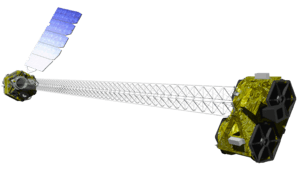NuSTAR facts for kids
NuSTAR is a special telescope that flies in space. NASA launched it in 2012. It was the eleventh satellite in a program called "Small Explorer". Space telescopes can see much better than telescopes on Earth. This is because Earth's atmosphere gets in the way.
NuSTAR looks at high-energy X-rays. These X-rays are a type of light with very high energy. They have a much higher frequency than the visible light we can see. NuSTAR uses special optical tools to do this. It works differently from a regular telescope. This kind of telescope is called a Wolter telescope.
NuSTAR helps scientists study black holes. It also looks at supernovae, which are huge star explosions. This helps us learn how chemical elements are made. One of NuSTAR's first big finds was with another telescope, XMM-Newton. They measured how fast a supermassive black hole spins for the very first time.
Contents
What is NuSTAR?
NuSTAR stands for Nuclear Spectroscopic Telescope Array. It is a space telescope that studies the universe. It was launched on June 13, 2012. NuSTAR travels around Earth in orbit.
Why is NuSTAR Special?
NuSTAR is special because it sees X-rays. These X-rays are very powerful. They come from extreme places in space. These places include black holes and exploding stars. Our eyes cannot see X-rays.
NuSTAR helps us understand these powerful events. It gives us a new way to look at the universe.
How NuSTAR Sees X-rays
NuSTAR uses a special design to see X-rays. Regular telescopes use mirrors to focus visible light. X-rays are different. They would just go through normal mirrors.
Wolter Telescope Design
NuSTAR uses a special type of mirror called a Wolter telescope. These mirrors are shaped like cones. X-rays hit them at a very shallow angle. This makes the X-rays bounce off the mirrors. They then go to the detectors.
NuSTAR has two sets of these special mirrors. They are very smooth and precise. This helps NuSTAR collect many X-rays.
Detecting High-Energy Light
After the X-rays bounce off the mirrors, they hit a detector. This detector is like a camera for X-rays. It records where the X-rays came from. It also records how much energy they have. This information helps scientists create X-ray images.
What NuSTAR Studies
NuSTAR helps scientists learn about some of the most exciting things in space. It looks at black holes. It also studies how stars explode.
Exploring Black Holes
Black holes are areas in space with very strong gravity. Nothing, not even light, can escape them. NuSTAR looks for black holes. It studies how they grow. It also helps us understand how they affect their surroundings.
NuSTAR helped measure the spin of a supermassive black hole. This was a very important discovery. It tells us more about how these giant objects work.
Understanding Supernovae
A supernova is a huge explosion of a star. These explosions are very bright. They create many of the chemical elements we see around us. NuSTAR studies supernovae. It helps us understand how these elements are made. It also shows us how stars end their lives.
Images for kids
See also
 In Spanish: NuSTAR para niños
In Spanish: NuSTAR para niños





